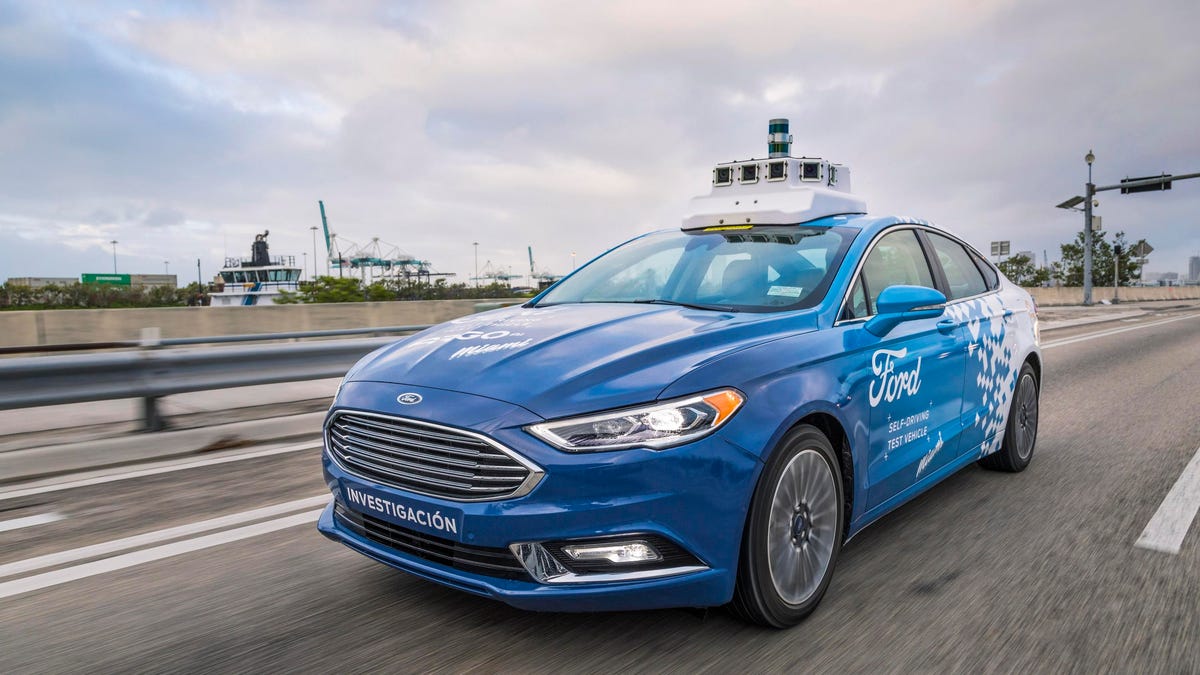Ford warns FCC car-to-car communications proposal is unsafe
The automaker doesn't want to give up any spectrum to Wi-Fi.

A prototype Ford autonomous vehicle cruises around Miami. Ford plans to bring the C-V2X technology to its cars in 2022.
An FCC proposal to offer a portion of new radio spectrum for ordinary Wi-Fi use would make car-to-car communications unsafe and could squelch advancements in self-driving cars , Ford warned in comments filed Monday.
The automaker wants all the spectrum in a swath of airwaves near the 5.9GHz frequency band to be available for a technology called C-V2X, short for cellular vehicle-to-everything communications. C-V2X repurposes the mobile network technology in your phone to let cars talk to each other, as well as traffic signals and other devices. C-V2X could be used to improve safety today, while laying the foundation for self-driving cars to band together into energy efficient "platoons."
Ford's comments come as a response to a proposal made by the Federal Communications Commission in December. The spectrum had been allocated for an older car-to-car communication technology, Dedicated Short-Range Communications, or DSRC, that hasn't gained widespread adoption. Now the FCC is considering other uses.
If the FCC goes ahead with its sharing approach, Ford believes, the agency will hurt safety and hobble automotive progress. "C-V2X will give people the ability to move more freely and more safely than ever before," Don Butler, executive director of Ford's connected vehicle services unit, said in a press briefing. "Crash avoidance will mitigate congestion, reduce carbon emissions, and lead to more widespread socioeconomic benefits."
The debate is one of many around the world about the best way to use scarce radio spectrum. Carving off portions of the airwaves for particular uses helps protect those uses from interference and, in the case of mobile networks, raises billions of dollars in government auctions. But unlicensed use opens the door for other public benefits and for innovation like a proposed smart home network from Apple, Amazon and Google.
The FCC offered to split the new airwaves between vehicular use and unlicensed spectrum open to anybody. That pleased the outfits like the Wi-Fi Alliance, an industry consortium, and internet service providers Comcast and Charter Communications. But Ford isn't happy.
The Wi-Fi Alliance declined to comment. The FCC didn't respond to a request for comment.
Carving up wireless spectrum
For the last two decades, a total of 75MHz of spectrum has been available for DSRC. That technology hasn't caught on widely, though, so the FCC is considering other uses. In December, it proposed 45MHz of it be released as unlicensed spectrum open to uses like Wi-Fi, 20MHz be reserved for C-V2X, and 10MHz for DSRC. If DSRC fans failed to persuade a skeptical FCC their use was warranted, that 10MHz would be shifted over to C-V2X.
"For the purposes of safety as well as the great societal benefits, we think it's necessary to preserve the entire 75MHz band," Butler said. "When W-Fi is operating in the channels proposed, it detracts from our ability to communicate with low latency and with the kind of response time necessary to prevent those accidents."
But NXP Semiconductors, a Dutch chipmaker that sells processors to carmakers worldwide and a longtime DSRC champion, doesn't see things entirely Ford's way. Allocating just 30MHz of spectrum "will not be enough for either DSRC or C-V2X," it said in its own Monday filing, but it wants the FCC to preserve the spectrum for the "mature technology" of DSRC.
Ford C-V2X tests
Ford conducted real-world tests in which it modified existing Wi-Fi equipment to use the new 45MHz of spectrum. Its conclusion: Wi-Fi devices' radio signals spill out into spectrum they aren't supposed to use. The interference caused would reduce C-V2X communication distances from 604 meters to 137 meters, a threshold well below the National Highway Transportation Safety Administration's 300-meter minimum, Ford said.
"This would render applications such as electronic emergency brake light and forward collision warning ineffective," Ford said in its filing.
Separately, the FCC has proposed making a large swath of higher-frequency 6GHz airwaves available for a dramatic expansion of unlicensed spectrum. Ford isn't concerned about this expansion affecting C-V2X, in part because its higher-frequency signals don't propagate as far and therefore cause less interference, Butler said.

